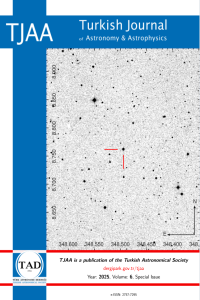Abstract
Uzay havası; Güneş patlamalarından açığa çıkan yüksek enerjili parçacıkların Yer atmosferiyle etkileşime girmesi sonucu oluşan jeomanyetik fırtınaların iklim, havacılık, uydu teknolojileri ve yer tabanlı teknoloji sistemleri üzerindeki etkilerini inceleyen alandır. Güneş’in doğasının henüz tam anlamıyla keşfedilmemiş olması bizleri ve ürettiğimiz teknolojiyi Güneş’ten gelebilecek beklenmedik etkilere karşı savunmasız bırakmaktadır. Dolayısıyla uzay havası çalışmaları, Güneş aktivitesini ve Yer’e olan etkilerini inceleyerek olası tehlikelere karşı erkenden önlemler almayı amaçlar. Bu çalışmada 25. Güneş Çevrimi süresince Güneş aktivitesi ve uzay havası arasındaki ilişki incelenmiştir. Güneş leke sayımları, Güneş X-ışın akısı, Ap indeksi ve Dst indeksi verileri birlikte değerlendirilmiş, Güneş aktivitesiyle uzay havası verilerinin değişimi grafikleri karşılaştırılarak aralarında korelasyon olup olmadığı araştırılmıştır.
Keywords
References
- Ahluwalia H. S., 2019, Advances in Space Research, 64, 1093
- Carrington R. C., 1859, MNRAS, 20, 13
- Gleissberg W., 1971, Sol. Phys., 21, 240
- Green S. B., Salkind N. J., Jones T. M., 1996, Using SPSS for Windows; Analyzing and Understanding Data, 1st edn. Prentice Hall PTR, Upper Saddle River, NJ, USA
- Hale G. E., Ellerman F., Nicholson S. B., Joy A. H., 1919, ApJ, 49, 153
- Hathaway D. H., 2010, Living Reviews in Solar Physics, 7, 1
- Malandraki O. E., Crosby N. B., 2018, in Malandraki O. E., Crosby N. B., eds, Astrophysics and Space Science Library Vol. 444, Solar Particle Radiation Storms Forecasting and Analysis. pp. 1–26, doi:10.1007/978-3-319-60051-2_1
- Parker E. N., 2009, Space Sci. Rev., 144, 15
- Rathore B. S., 2021, Indian Journal of Radio & Space Physics, 50, 142
- Reames D. V., 2004, Advances in Space Research, 34, 381
- Richardson I. G., 2013, Journal of Space Weather and Space Climate, 3, A08
- Samwel S., Miteva R., 2023, Advances in Space Research, 72, 3440
- Schad T. A., Penn M. J., 2010, Sol. Phys., 262, 19
- Schuh H., ve diğ., 2021, PASP, 133, 104503
- Schwabe H., 1844, Astronomische Nachrichten, 21, 233
- Tapping K., 2013, in Chapman D. M. F., ed., Royal Astronomical Society of Canada Observer’s Handbook 2013. Royal Astronomical Society of Canada, p. 189
Abstract
Space weather is the field that examines the effects of geomagnetic storms, which result from the interaction between high-energy particles released during solar flares and the Earth’s atmosphere, on climate, aviation, satellite technologies, and ground-based technological systems. The incomplete understanding of the Sun’s nature leaves us and the technology we produce vulnerable to unexpected impacts from the Sun. Therefore, space weather studies aim to investigate solar activity and its effects on Earth, enabling the adoption of early measures against potential hazards. In this study, the relationship between solar activity and space weather during Solar Cycle 25 was examined. Sunspot counts, solar X-ray flux, the Ap index, and the Dst index were evaluated together, and graphs depicting the variations in solar activity and space weather data were compared to investigate whether there is a correlation between them.
Keywords
References
- Ahluwalia H. S., 2019, Advances in Space Research, 64, 1093
- Carrington R. C., 1859, MNRAS, 20, 13
- Gleissberg W., 1971, Sol. Phys., 21, 240
- Green S. B., Salkind N. J., Jones T. M., 1996, Using SPSS for Windows; Analyzing and Understanding Data, 1st edn. Prentice Hall PTR, Upper Saddle River, NJ, USA
- Hale G. E., Ellerman F., Nicholson S. B., Joy A. H., 1919, ApJ, 49, 153
- Hathaway D. H., 2010, Living Reviews in Solar Physics, 7, 1
- Malandraki O. E., Crosby N. B., 2018, in Malandraki O. E., Crosby N. B., eds, Astrophysics and Space Science Library Vol. 444, Solar Particle Radiation Storms Forecasting and Analysis. pp. 1–26, doi:10.1007/978-3-319-60051-2_1
- Parker E. N., 2009, Space Sci. Rev., 144, 15
- Rathore B. S., 2021, Indian Journal of Radio & Space Physics, 50, 142
- Reames D. V., 2004, Advances in Space Research, 34, 381
- Richardson I. G., 2013, Journal of Space Weather and Space Climate, 3, A08
- Samwel S., Miteva R., 2023, Advances in Space Research, 72, 3440
- Schad T. A., Penn M. J., 2010, Sol. Phys., 262, 19
- Schuh H., ve diğ., 2021, PASP, 133, 104503
- Schwabe H., 1844, Astronomische Nachrichten, 21, 233
- Tapping K., 2013, in Chapman D. M. F., ed., Royal Astronomical Society of Canada Observer’s Handbook 2013. Royal Astronomical Society of Canada, p. 189
Details
| Primary Language | Turkish |
|---|---|
| Subjects | Astronomical Sciences (Other) |
| Journal Section | Articles |
| Authors | |
| Early Pub Date | June 22, 2025 |
| Publication Date | July 1, 2025 |
| Submission Date | December 2, 2024 |
| Acceptance Date | May 9, 2025 |
| Published in Issue | Year 2025 Volume: 6 Issue: Special Issue: UAK2024 Proceedings of the 23rd National Astronomy Congress |
TJAA is a publication of Turkish Astronomical Society (TAD).


